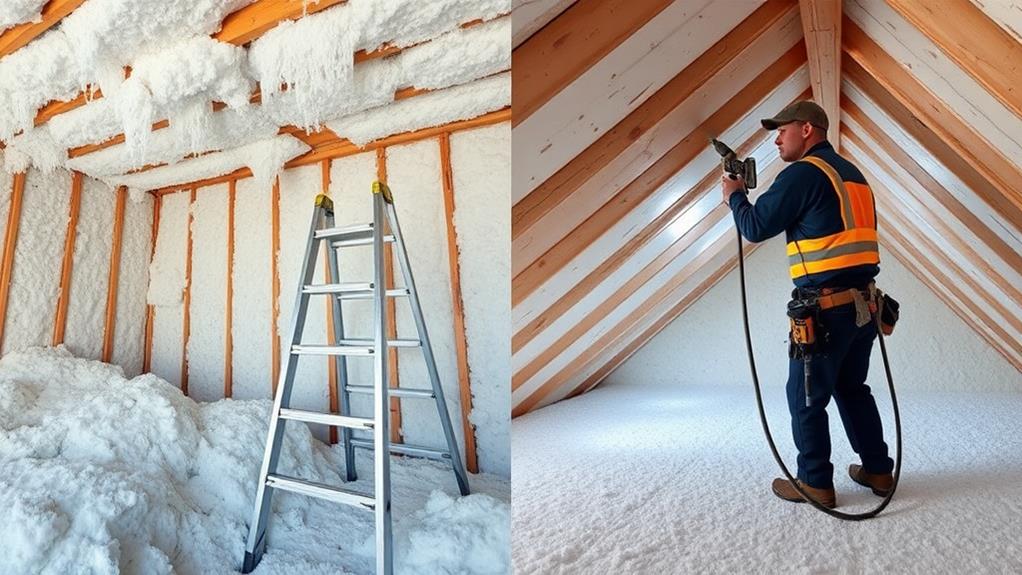When deciding between DIY and professional insulation installation, you'll need to weigh several factors. DIY can be more budget-friendly, but it requires significant time investment and carries risks of mistakes. Professional installation offers expertise, efficiency, and often comes with warranties, but at a higher cost. Safety is a crucial consideration, as insulation materials can be hazardous to handle. While DIY allows for more control, professionals have access to specialized equipment and high-quality materials. Your choice will depend on your skills, time availability, and budget. Consider the long-term energy savings and potential pitfalls before making your decision. The right choice can make a world of difference in your home's comfort and efficiency.
Cost Comparison
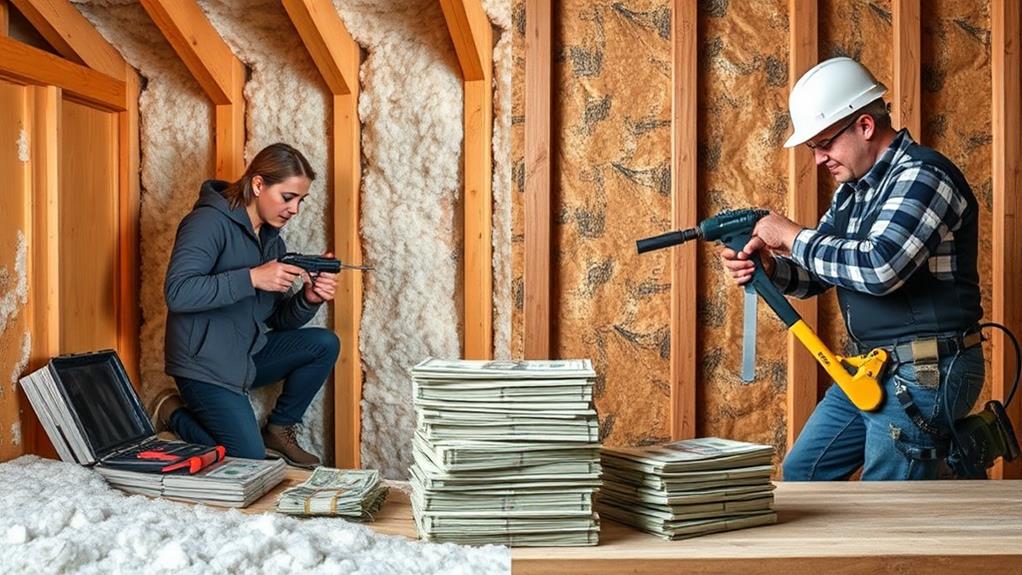
Why do homeowners often consider DIY insulation? The answer is simple: cost savings. At first glance, DIY insulation appears to be the more budget-friendly option. You'll avoid labor costs, which can account for a significant portion of professional installation fees. Materials for DIY insulation projects are readily available at home improvement stores, and you can purchase only what you need.
However, the cost comparison isn't always straightforward. Professional installers often have access to wholesale prices on materials, potentially offsetting some of their labor costs. They also come equipped with specialized tools that you might need to rent or purchase for a DIY job.
Consider the long-term costs as well. If you make mistakes during installation, you may face higher energy bills or need to redo the work later. Professionals typically offer warranties on their work, protecting you from future expenses.
It's crucial to factor in the value of your time. DIY insulation can be time-consuming, especially if you're inexperienced. Weigh the cost of your labor against the price of professional installation to make an informed decision.
Time Investment
The time investment for DIY insulation can be substantial, especially for those new to home improvement projects. You'll need to dedicate hours to research, planning, and preparation before you even begin the actual installation. This includes learning about insulation types, safety precautions, and proper installation techniques.
When you're ready to start, you'll likely spend several days to weeks completing the project, depending on the size of your home and the complexity of the job. You'll need to factor in time for measuring, cutting, and fitting insulation, as well as addressing any unexpected issues that arise during the process.
In contrast, professional installers can typically complete the job in a fraction of the time. Their experience and specialized equipment allow them to work efficiently, often finishing an entire home in just one or two days. This quick turnaround minimizes disruption to your daily life and allows you to enjoy the benefits of improved insulation sooner.
Consider your available time and skill level when deciding between DIY and professional installation. If you're time-constrained or value a swift completion, hiring professionals might be the better choice.
Quality of Work
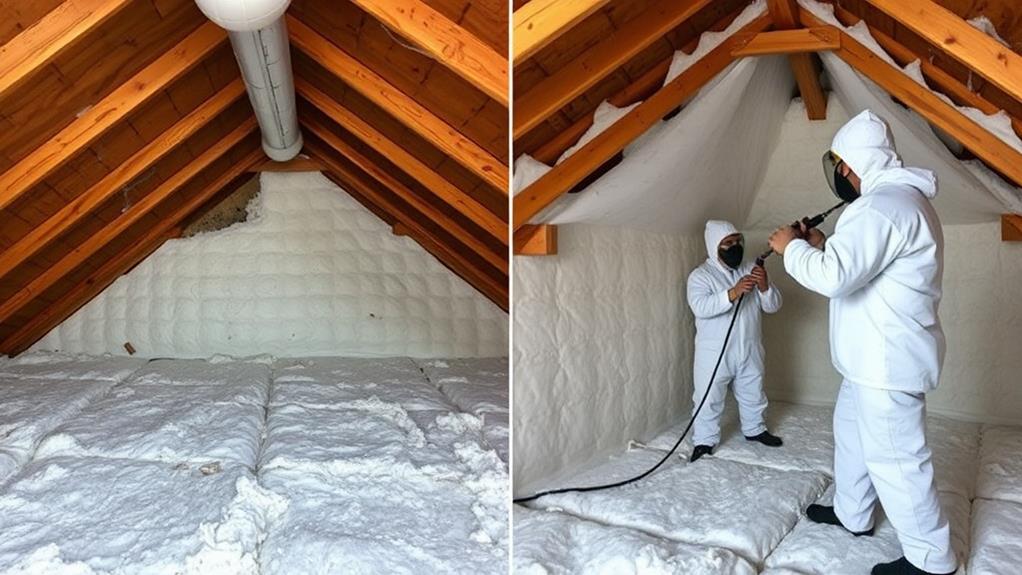
While the time investment is a key consideration, the quality of the finished work is equally important. When it comes to insulation installation, professionals have the edge in delivering superior results. They're trained to identify and address potential issues, such as air leaks or moisture problems, that you might overlook. They also have access to specialized equipment and high-quality materials that can enhance the insulation's effectiveness.
If you're tackling a DIY insulation project, you'll need to educate yourself on proper techniques and safety precautions. You might make mistakes, such as compressing fiberglass insulation or leaving gaps, which can significantly reduce its efficiency. Additionally, you may struggle with hard-to-reach areas or complex installations, potentially compromising the overall effectiveness of your insulation.
However, if you're detail-oriented and willing to invest time in learning, you can achieve satisfactory results with DIY insulation. It's crucial to research thoroughly, follow manufacturer guidelines, and use appropriate safety gear. Remember that even small errors can lead to reduced energy efficiency and potential problems down the line. Ultimately, the quality of work depends on your skill level, attention to detail, and willingness to invest in the right tools and materials.
Safety Considerations
Safety concerns are paramount when it comes to insulation installation, whether you're a DIY enthusiast or a professional. When tackling insulation as a DIY project, you'll need to be aware of potential hazards. Fiberglass can irritate your skin, eyes, and respiratory system, so proper protective gear is essential. You'll need to wear a mask, goggles, gloves, and cover exposed skin.
Working in attics or crawl spaces can also be dangerous due to unstable flooring and poor lighting. Professionals are trained to handle these risks and have the right equipment. They're also familiar with electrical wiring and can spot potential fire hazards. If you're dealing with old insulation, there's a risk of encountering asbestos, which requires specialized removal. Professionals can identify and safely handle this situation.
DIY insulation installation may save you money, but it comes with increased safety risks. You'll need to educate yourself on proper techniques and safety protocols. On the other hand, hiring professionals ensures the job is done safely, but at a higher cost. Consider your skills, the complexity of the project, and your comfort level with potential risks when deciding between DIY and professional installation.
Equipment and Tools Required
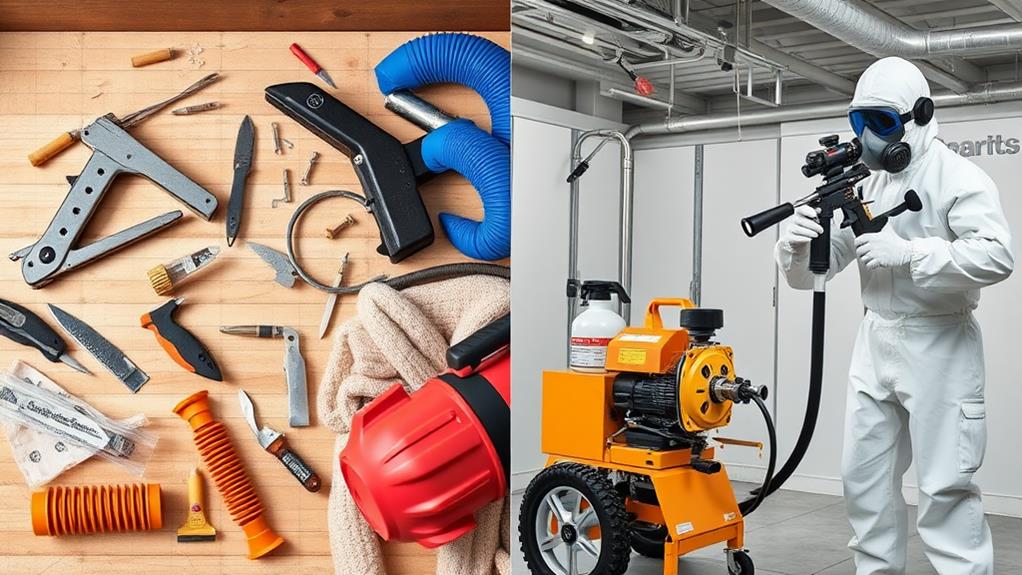
Toolboxes for DIY and professional insulation installation differ significantly in their contents and complexity.
For a DIY project, you'll need basic tools like a utility knife, measuring tape, straightedge, and staple gun. You'll also require safety gear, including a dust mask, safety goggles, and work gloves. A ladder or scaffolding might be necessary for hard-to-reach areas.
Professional installers, on the other hand, come equipped with specialized tools designed for efficiency and precision. They'll have commercial-grade insulation blowers for loose-fill installations, foam spray equipment for spray foam insulation, and vapor barrier applicators. They also use infrared cameras to detect heat loss and moisture meters to assess potential dampness issues.
Both DIY and professional approaches require proper protective equipment, but professionals often have more advanced gear like respirators with filters for harmful particles. They'll also have tools for air sealing, such as caulking guns and expanding foam dispensers. While you can rent some professional-grade equipment for DIY use, it's important to consider the learning curve and potential risks associated with operating unfamiliar tools, especially when working with spray foam or loose-fill insulation.
Types of Insulation Materials
The tools you use are only part of the equation; the insulation material itself plays a major role in the success of your project. When choosing between DIY and professional installation, it's crucial to understand the different types of insulation available.
Fiberglass batts are a popular DIY option, as they're easy to handle and fit between wall studs or attic joists. However, they can be less effective if not installed correctly. Blown-in cellulose is another option, offering better coverage but requiring specialized equipment. Spray foam insulation provides excellent air sealing and insulation value but is typically best left to professionals due to its complexity and potential health risks during application.
For DIYers, rigid foam boards are versatile and can be cut to size, making them suitable for various applications. Reflective insulation, consisting of foil-faced materials, is effective in hot climates and can be a manageable DIY project. On the professional side, you'll find options like injection foam, which can be added to existing walls without major demolition. Professionals also have access to higher-grade materials and can ensure proper installation of more complex insulation types, potentially leading to better long-term performance and energy savings.
Long-Term Energy Savings
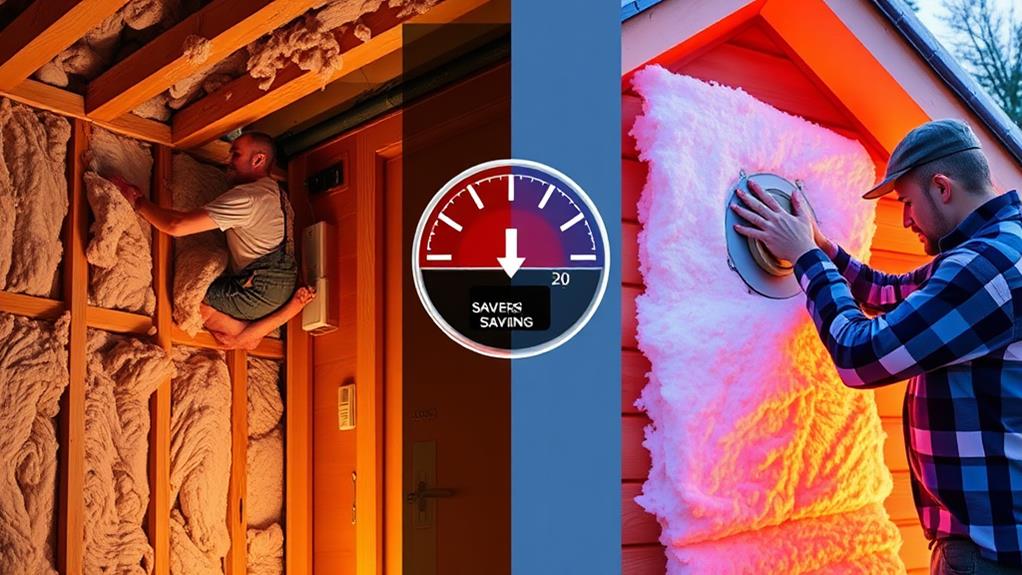
Ultimately, the decision between DIY and professional insulation installation often comes down to long-term energy savings. When you choose to install insulation yourself, you'll save money upfront, but you might miss out on potential energy savings if the job isn't done correctly. Professional installers have the expertise to ensure proper coverage and sealing, which can lead to greater energy efficiency in the long run.
You'll need to consider the R-value of your insulation and how it impacts your home's energy performance. Professionals can help you select the right type and amount of insulation for your specific needs, potentially maximizing your energy savings. They'll also be aware of local building codes and energy efficiency standards, ensuring your installation meets or exceeds requirements.
While DIY installation might seem cost-effective initially, poorly installed insulation can lead to higher energy bills and reduced comfort. Professional installation, though more expensive upfront, often pays for itself through increased energy savings over time. You'll also benefit from warranties and guarantees that come with professional work, providing peace of mind and potential cost savings if issues arise in the future.
Common Mistakes to Avoid
When tackling insulation installation, whether as a DIY project or with professional help, it's crucial to be aware of common pitfalls. One frequent mistake is choosing the wrong type of insulation for your specific needs. Ensure you select the appropriate R-value and material for your climate and home structure.
Another error is failing to address air leaks before installing insulation. Seal all gaps and cracks in walls, floors, and ceilings to maximize efficiency. Don't forget to insulate around electrical outlets and light fixtures, as these are often overlooked sources of heat loss.
Improper installation techniques can significantly reduce insulation effectiveness. Avoid compressing fiberglass batts, as this decreases their insulating power. When using spray foam, apply it evenly and at the correct thickness to achieve optimal performance.
Neglecting proper safety measures is a serious mistake. Always wear protective gear, including a respirator, goggles, and gloves. Ensure adequate ventilation when working with spray foam or fiberglass.
Lastly, don't overlook the importance of vapor barriers. Incorrect placement can lead to moisture problems and reduced insulation efficiency. Make sure you understand your local building codes and climate requirements before installation.
Building Code Compliance
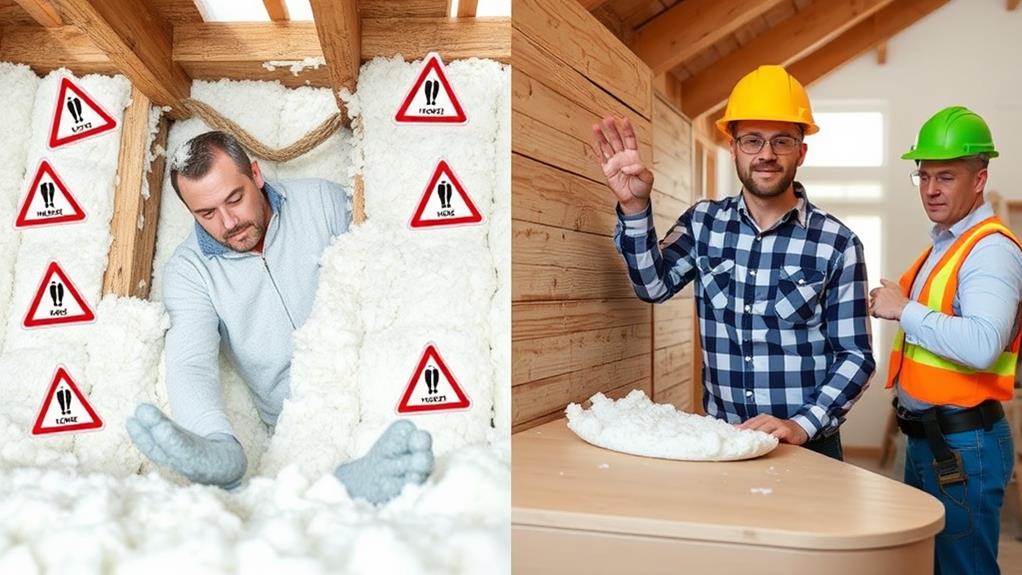
Building codes play a vital role in both DIY and professional insulation projects. When you're considering insulation installation, it's crucial to understand that these codes aren't just suggestions—they're legal requirements designed to ensure safety and energy efficiency.
Professional installers are typically well-versed in local building codes and stay updated on any changes. They'll ensure your insulation project meets all necessary standards, from R-value requirements to fire safety regulations. If you're going the DIY route, you'll need to research and familiarize yourself with these codes before starting.
You'll need to consider factors like vapor barriers, air sealing, and proper ventilation. Failing to comply with building codes can lead to failed inspections, potential fines, and even the need to redo the work. It's not just about the immediate consequences; non-compliant insulation can affect your home's energy efficiency and safety in the long run.
If you're unsure about code compliance, it's worth consulting with a professional or your local building department. They can provide guidance on specific requirements for your area and project type, helping you avoid costly mistakes and ensure a code-compliant insulation installation.
Warranty and Insurance Coverage
A safety net of warranties and insurance coverage can make a significant difference in your insulation project. When you opt for professional installation, you'll often receive manufacturer and workmanship warranties. These typically cover material defects and installation errors for a specified period, giving you peace of mind and financial protection.
DIY installations, however, may void product warranties or limit your coverage options. You'll be responsible for any mistakes or damage caused during the installation process. Additionally, most homeowners' insurance policies won't cover DIY work if it leads to property damage or injury.
Professional installers usually carry liability insurance and workers' compensation coverage. This protects you from potential lawsuits if someone gets injured on your property during the installation. It also safeguards against accidental damage to your home.
When choosing between DIY and professional installation, consider the long-term benefits of comprehensive warranty and insurance coverage. While DIY may seem cost-effective initially, the potential risks and lack of protection could outweigh the savings. Evaluate your skill level, the complexity of the project, and the value of having a safety net before making your decision.
Conclusion
Weighing the pros and cons of DIY vs. professional insulation installation is like navigating a thermal maze. You'll need to consider your budget, time, skills, and safety. While DIY can save money upfront, professionals bring expertise and efficiency. Ultimately, your decision should hinge on your comfort level and the complexity of the job. Whatever you choose, don't cut corners on quality—proper insulation is the warm embrace your home deserves for years to come.
